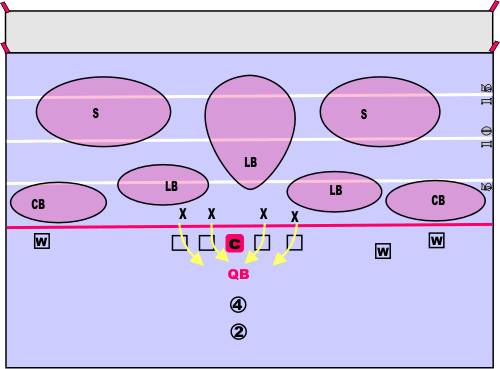Understanding the Colts Defense
Recently the National Football Post started a series that hopes to give football fans a basic understanding of how traditional NFL defenses work. To start, Matt Bowen wrote a piece explaining the basic Cover 2 defensive arrangement in this story.
The diagram shows how the safeties and middle linebacker traditionally will drop into a what amounts to a cover 3 arrangement, meaning there are three players who drop back in a “deep zone” in their respective areas on the field. This defense encourages opponents to get rid of the ball in a short field, limits yards after the catch, and relies on the defensive linemen to generate pressure before opposing receivers can stretch the field and get behind the zone coverage.

Mohammed Alo | The Football Times
The problem with the basic cover 2 defensive system is two-fold, as it relates to the Colts. First, the cover 2 relies upon generating pressure on the quarterback to be effective and absent that pressure the zone will expand, meaning holes are created and openings for opponents in the short passing game and on delayed runs become an issue. Second, the Colts do not run a traditional cover 2 on most downs.
The second part of the Colts general defensive scheme is called a one-gap defensive arrangement, particularly in run containment. This ultimately means that two things happen that alters the diagram above. First, each “gap” is found on the inside and outside of each offensive lineman. As a result, there is a gap outside each of the tackles, inside of each of the tackles, and inside each of the guards. A total of six gaps exist which four defensive linemen and two other defenders are assigned to the remaining gaps.
Second, since Larry Coyer has arrived in Indianapolis, the Colts rely more on man-coverage in pass defense than they have at any other time in the past. This means that the cornerbacks in particular will draw an assignment, typically one of the opponent’s wide receivers and will stick with that assignment beyond a typical cover 2 zone. It also means that one of the safeties will likely come down and pick up a third receiver or tight end earlier than in a typical cover 2 zone.
Ultimately, it makes the Colts defense look more like a Cover 1, with a safety in a deep zone over the top of each of the defensive backs to help, with one linebacker serving more as a roamer who may key off of a particular player. This player is often a running back or opposing H-Back but this roaming linebacker or additional cornerback in a nickel package will play with enough space to assist in a short zone against delays, short pass routes, and possibly to blitz.
The mantra in Indianapolis from defensive line coach John Teerlinck is that the Colts play the run on the way to the quarterback. This strategy is consistent with the idea that in a defense that is built on speed, and plays in cover 1 or cover 2 pass coverage a majority of the time, that getting pressure on the quarterback is key and that staying true to gaps in the one-gap system is essential if the defense plans on effectively thwarting opponents’ ground games.
This system requires a bit of a gamble, like most any defensive systems, because if defenders fail to fill their assigned gaps or fail to generate pressure on the quarterback, the gaps in zone and man coverages widen and the opportunity for eight to ten yard passes opens significantly. This phenomenon was apparent at no time more than in the Super Bowl, with Dwight Freeney hobbled, the Colts unable to generate pressure, the defenders who were actively filling their gap assignments taking themselves out of short-zones, and a quick-release strategy by Drew Brees and Sean Payton that was designed to capitalize on the gaps in short zones, which the man coverage by Colts corners on the outside helped to create.
In an effort to combat these problems, the Colts have focused more on bringing in linebackers who can effectively defend the pass, have focused on bringing in defensive backs who excel more in man-to-man coverage, and have added Jerry Hughes to boost the overall pressure generating talent on the team and marginalize the team’s reliance on Freeney and Mathis playing at 100-percent. The fact is, if the Colts defense can generate pressure, and opposing quarterbacks are forced to move around in the pocket or outside of it, the likelihood of sacks, loss of yards, and the ability to exploit gaps in short-zones drops dramatically.
It will be interesting to see how the Colts new weapons will effect Coyer’s system and how the effectiveness of Coyer’s changes to the cover 2 will change with team’s defensive players having a full season to get used to them. Still, it’s important for fans to realize that the Colts no longer rely on a traditional Cover 2 defense for the majority of each game. Look for these themes as the Colts play in the new season and fans may be able to have a better understanding of how and why the Colts defense is succeeding or failing, along with which players are most responsible for those successes and failures on each down.
| Print article | This entry was posted by Brett Mock on May 26, 2010 at 2:50 am, and is filed under Colts Academy. Follow any responses to this post through . You can skip to the end and leave a response. Pinging is currently not allowed. |
